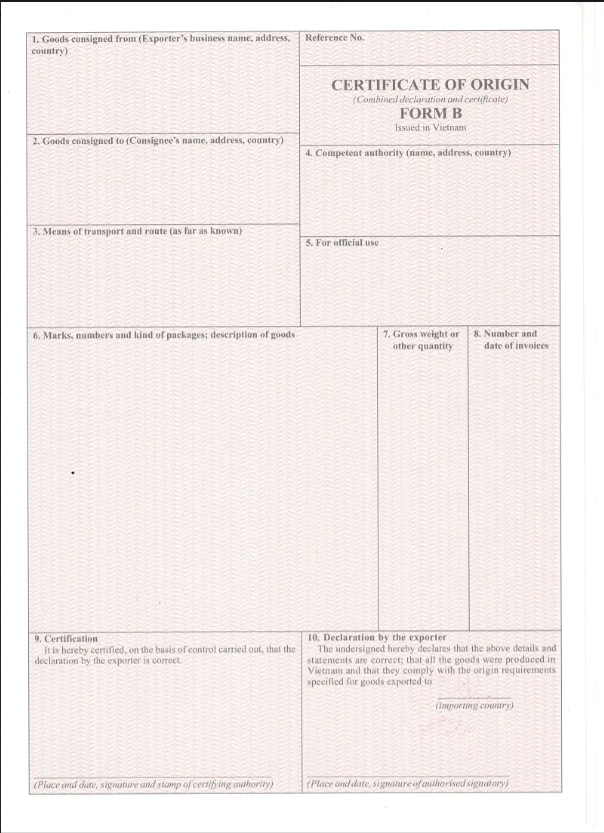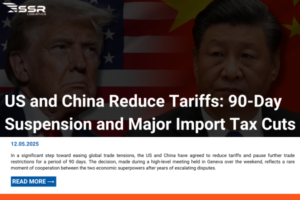The Certificate of Origin (C/O) plays an essential role in import and export activities. Although it may seem simple, fully and accurately understanding the information related to the CO is not easy for businesses participating in this process. Having a clear understanding of the content and proper use of the CO is very necessary for import and export businesses to comply with current regulations and protect their interests to the maximum extent.
Realizing this, the following article from SSR Logistics will provide you with a comprehensive view of the CO terminology, helping you effectively address this challenge.
Certificate of Origin (C/O) for Goods
What is a Certificate of Origin (C/O)?
The Certificate of Origin for goods, or C/O, plays an extremely important role in import and export activities. The C/O plays a crucial role in determining the country of production of goods, thereby helping to apply appropriate customs policies and trade preferences.
The Certificate of Origin (C/O) is an official document issued by the competent authority of the exporting country for goods produced within its territory. To ensure legality and validity, the C/O must strictly comply with the rules of origin regulations of both the exporting and importing countries. Specifically, the C/O needs to accurately reflect the production origin of the goods according to the rules of origin stipulated by the exporting country. At the same time, the C/O must also meet the requirements and standards set by the importing country in recognizing the origin of goods to ensure compliance with bilateral or multilateral trade agreements.
Functions of the Certificate of Origin (C/O) for Goods
The Certificate of Origin (C/O) plays an important role in imports and exports:
- Customs duty preferences: The C/O helps distinguish imported goods that are eligible for customs duty preferences under the free trade agreements (FTAs) signed between countries. Based on this, customs authorities can apply appropriate import duty preference policies.
- Anti-dumping, anti-circumvention: In cases where a country’s goods are dumped or illegally subsidized in another country’s market, accurately determining the origin through the C/O will help make anti-dumping and countervailing duty measures more feasible and effective.
- Trade statistics and quota management: The C/O provides accurate origin information, thereby facilitating the collection of trade statistics data for each country or region. On this basis, trade authorities can effectively maintain and manage the import quota system.
- Trade promotion: With the ability to verify the origin and quality of goods, the C/O becomes an effective tool in promoting import and export activities and expanding consumer markets.

Functions of the Certificate of Origin (C/O)
Significance of the Certificate of Origin (C/O) for Goods
- For exporters: The C/O is proof that the exported goods meet the origin requirements and help increase credibility and expand consumer markets. However, the process of applying for a C/O can sometimes be complex and costly.
- For importing businesses: The C/O helps verify the origin of goods, ensures compliance with importing country regulations, and allows for customs duty preferences, avoiding the risk of violating trade policies.
- For government agencies: The C/O is a tool for managing and controlling import and export activities, applying appropriate trade policies, protecting national interests, and promoting international trade.
In summary, the Certificate of Origin (C/O) for goods plays an essential role in verifying the origin of goods, facilitating international trade activities, while also helping regulatory authorities effectively implement trade policies.
Classification of COs in Vietnam
Common Types of COs in Vietnam
As of now, Vietnam has participated in and is participating in 19 bilateral and multilateral FTAs with most economies around the world. Corresponding to each FTA, there is a separate Certificate of Origin (CO) form. Using the correct type of CO corresponding to the FTA is a prerequisite for Vietnam’s exported goods to enjoy the special preferential import duty rate committed in that agreement.
In addition, there are also regular types of COs that only certify the origin of goods without accompanying special customs duty preferences. These types of COs are used for import and export cases that are not covered by FTA preferences.
Therefore, depending on the specific type of goods, destination country and origin country, import and export businesses need to identify and use the appropriate CO form to ensure compliance with regulations on the origin of goods and enjoy corresponding customs duty preferences (if any).
- CO Form A: For goods exported from Vietnam to enjoy special customs duty preferences from importing countries, especially important when wanting to take advantage of free trade agreements (FTAs).
- CO Form B: Used for exports from Vietnam when not meeting conditions for customs duty preferences under FTAs.
- CO Form D: Applies to goods exported between member countries of the Association of Southeast Asian Nations (ASEAN).
- CO Form E: Particularly important for trade between ASEAN and China.
- CO Form EAV: For goods exported between Vietnam and member countries of the Eurasian Economic Union.
- CO Forms AK and KV: For trade between ASEAN and South Korea, as well as between Vietnam and South Korea.
- CO Forms AJ and VJ: This applies to goods exported between ASEAN and Japan, as well as between Vietnam and Japan.
- CO Form AI: For trade between ASEAN and India.
- CO Form AANZ: For goods exported between ASEAN, Australia and New Zealand.
- CO Form VC: Applies to goods exported between Vietnam and Chile.
- CO Form S: For trade between Vietnam and neighboring countries Laos and Cambodia.
In summary, there are many different types of COs serving Vietnam’s import and export activities with trading partners around the world, in each type of CO will provide different customs duty preferences depending on the specific FTA agreement.

Sample Certificate of Origin (CO)
Classification of Certificates of Origin (CO)
The classification of COs is based on the level of customs duty preference applied to exported goods. It includes preferential COs and non-preferential COs.
- Preferential CO:
This is the type of CO that helps businesses enjoy customs duty preferences when exporting goods to countries with Free Trade Agreements (FTAs) or the Generalized System of Preferences (GSP). Common types of preferential COs include: CO Form A; CO Form E; CO Form AK; …
To be issued a preferential CO, the business must meet the following conditions:
-
- The goods must be produced in the preferential country.
- The goods must meet the rules of origin as prescribed by the FTA or GSP.
- The business must have a legitimate dossier as prescribed.
- Non-preferential CO:
This is the type of CO applied to exported goods to countries without FTAs or GSPs, or goods that do not meet the rules of origin to enjoy preferences. The common type is CO Form B.
Content in the CO
The Certificate of Origin (CO) provides authenticated information about the origin and place of production of goods from a specific country or territory. Typically, a CO will include the following contents:
- Type of CO: Currently there are 2 main forms: direct CO (issued by the country of origin or export) and back-to-back CO (issued by an exporting country other than the country of origin).
- CO Form: Indicates the standard form on which the CO is issued according to the regulations of the corresponding trade agreement.
- Party information: Names, addresses of the exporter and importer.
- Transportation information: Mode of transport, loading/unloading locations, bill of lading number…
- Goods details: Name of goods, type of packaging, brand, weight, quantity, value.
- Origin of goods: Specific place of origin, country of origin.
- Certification by the competent authority: Ensures the authenticity of the CO.
This information on the CO helps verify the accurate origin of the goods, meet the origin requirements to enjoy customs duty preferences under the agreement and serve the management and statistics of international trade activities.
Authorities, Timeframes and Fees for Obtaining a CO
Authorities Issuing Certificates of Origin (CO)
The process of obtaining a Certificate of Origin (CO) usually involves various authorities depending on the country and trade agreements.
In Vietnam, the following authorities have the power to issue Certificates of Origin for goods:
- VCCI (Vietnam Chamber of Commerce and Industry): Authorized to issue CO Forms A, B, and some others, VCCI plays an important role in supporting businesses to obtain COs for exported goods.
- Import-Export Management Departments of the Ministry of Industry and Trade: Specifically, the Import-Export Management Departments have the authority to issue CO Forms D, E, AK and some other forms. This helps divide responsibilities and enhance management efficiency in the CO application process.
- Industrial and Urban Zone Management Boards authorized by the Ministry of Industry and Trade: Responsible for issuing CO Forms D, E, AK and some other forms. Authorizing regional management boards helps reduce pressure and enhance professionalism in obtaining COs.
Timeframes and Fees for Obtaining a CO
Timeframe for issuing a CO:
- For electronic dossiers: Within 6 working hours from receiving a complete and valid dossier, the CO issuing authority must notify the review result on the system.
- For paper dossiers: Within 2 working hours from receiving the CO application and complete dossier, the CO issuing authority must return the result.
- Normal cases: The time for issuing a CO must not exceed 3 working days from receiving a complete and valid dossier.
- Cases requiring inspection at the production facility: The time for issuing a CO must not exceed 5 working days.
Fees for issuing a CO:
From May 21, 2022, the Ministry of Industry and Trade has stopped selling CO forms, switching to issuing them free of charge to businesses. Businesses will not have to pay fees for issuing COs, but must ensure submitting a complete and valid dossier to be issued a CO within the prescribed timeframe.
Procedures for Obtaining a CO from the Ministry of Industry and Trade
Step 1: Prepare Trader Profile Dossier
- For businesses applying for a CO for the first time, they must complete the Trader Profile Dossier on the ecosys.gov.vn system.
- Submit the Trader Profile Dossier along with a copy of the Business License and Tax Registration Certificate to the local Vietnam Chamber of Commerce and Industry (VCCI).
Step 2: Prepare Application Dossier for CO
- CO Application Form (sealed and signed by authorized representative)
- Corresponding CO form (A, B, D, E, AJ, AK, VK, VJ,…)
- Original commercial invoice
- Copy of completed export customs declaration (except for air cargo)
- Original Packing List
- Copy of Bill of Lading
- Production process
Step 3: Online Declaration
- Access the ecosys.gov.vn or comis.covcci.com.vn system
- Fully declare information on the system
- Print the draft CO slip after receiving the receipt number
Step 4: Submit Dossier and Receive Results
- Submit hard copy dossier along with draft CO slip directly to the issuing authority (VCCI/Ministry of Industry and Trade)
- Wait for the issuing authority to check, verify (if needed) and issue the CO within the prescribed timeframe
- Receive the original issued and stamped CO

Procedures for Getting a Certificate of Origin (CO)
Customs Clearance Services for Getting a CO
With over 15 years of experience in the logistics field, SSR Logistics has become a trusted partner of many shipping lines and airlines in Vietnam. We specialize in providing international freight forwarding services, comprehensive customs clearance, and Certificate of Origin (CO) obtainment services for businesses.
We provide comprehensive customs clearance services, including:
- Certificate of Origin for Goods (CO)
- HS code lookup
- Fumigation
- Plant and animal quarantine inspection
- Quality announcements for food, cosmetics, etc.
When using services at SSR Logistics, customers will be fully consulted and supported on procedures and documentation requirements promptly. Our experienced team will supervise and handle any issues that may arise smoothly, whether for small shipments or large project shipments. This ensures that the customs clearance and delivery of goods to customers is safe and fastest.
If any issues arise, SSR Logistics will handle them promptly to minimize costs beyond the initial quotation. We are committed to ensuring that customers’ goods are transported at the lowest and most competitive time and cost in the market.
Through this article, SSR Logistics hopes that our valued customers now have a comprehensive overview of the certificate of origin for goods For more articles, please visit our Logistics Knowledge section.
SSR looks forward to becoming your reliable logistics partner, providing optimal solutions for your importing and exporting business. Should you have any question regarding our services, please feel free to contact us for specific advice.
With our experienced team, extensive network and flexible shipping & customs solutions, SSR Logistics is confident to deliver excellent services to our clients.
Businesses that need customs and import-export consulting between Vietnam and Korea, please contact SSR Logistics via Hotline (+84) 911 988 484 or leave your information here for specific advice.
With a modern warehouse system and experienced transportation staff, SSR Logistics provides a variety of additional services such as: customs clearance, warehouse leasing, domestic transportation, international transportation by sea and air, and international express delivery.









